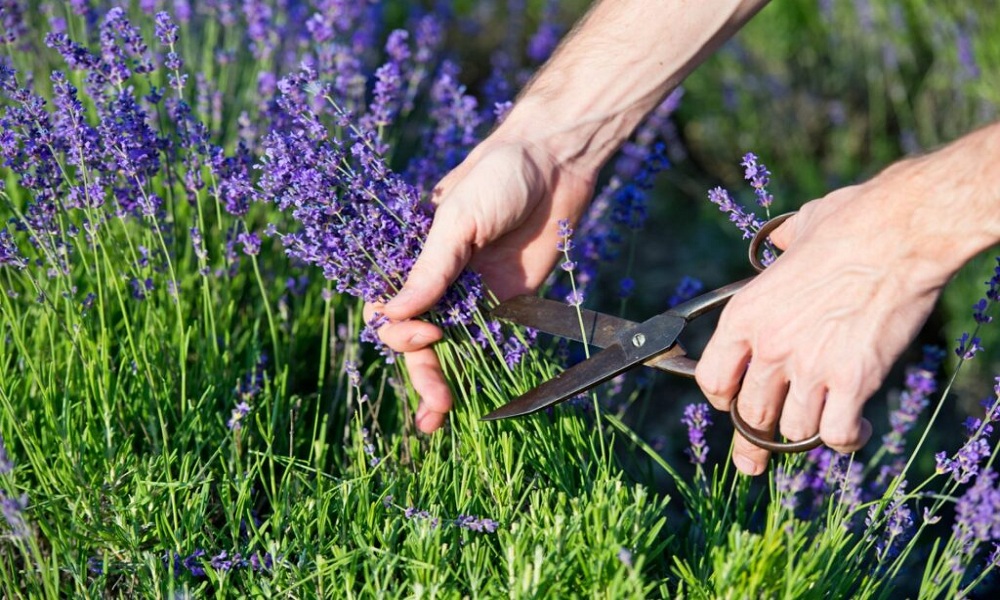It’s no surprise that the lovely and fragrant lavender flower is a popular addition to gardens of all kinds.
It takes very little effort and time to care for a lavender plant. However, yearly pruning of lavender plants is necessary to keep them content, healthy, and attractive.
The following tips will help you prune your lavender plants so that they remain full, bushy, and healthy for many years to come.
Why Prune Lavender?
Unpruned lavender bushes will quickly grow woody and unattractive, so regular pruning is essential. It may lose vitality and have a straggly, unsightly appearance due to the woody stems.
The woody stems will also fracture or break more easily, and will be more vulnerable to diseases and damage from frost or water rot.
By regularly cutting back your lavender bushes, you can maintain a neat and tidy landscape, and you’ll also halt the plant’s progression toward a woody, less flexible and less resilient state.
Lavender does not grow well from old wood, so if your bush has become woody and unhealthy, you should replace it.

The Proper Time for Lavender Pruning
It’s recommended that lavender, like other shrubs, be pruned once a year for optimal health.
If you want to prune lavender, do it in August or early September, after the flowers have finished for the season.
It’s possible that you’ve already done some pruning of the plants as you’ve gone along, removing blooming stems to use for various reasons around the house.
But now is the time to prune back the remaining flowering and non-flowering stems that you left for bees and other pollinators.
Lavender is often pruned in the late summer, after it has finished flowering, though spring pruning is also recommended by some sources.
Most plants benefit from a little trim in the spring to remove any ragged or frost-damaged branches and leaves left over from the winter. While it’s not strictly required, this can promote lush, healthy plant growth.
If the lavender flowers have faded in color, it’s time to prune. Without the bees’ attention, the blossoms will wither and turn a drab color.
If you discover a few purple flower heads that are still being visited by bees, you may want to leave them alone so that the pollinators have access to them even as the days get shorter.

How Much Should You Cut Off Your Plants?
After the flowers have faded, use pruners to trim back the plant’s current growth, leaving behind only the freshest, greenest shoots. If you have English lavender, you should feel comfortable pruning it back.
Your plant life will benefit greatly from annual pruning to keep it looking neat and healthy.
As long as you avoid damaging the small buds and green shoots that are growing on the lower woody material, you can safely remove the majority of the new, green growth. It is common practice, however, to prune back the plant by around 2.5 centimeters of its leafy growth and flowering stems in order to promote a fuller, bushier regrowth.

When Pruning Lavender, Keep Aesthetics in Mind
It’s crucial to avoid cutting back to old wood, as this could prevent the lavender from easily resprouting.
When selecting how much of your lavender plants to prune, it’s crucial to balance the plant’s needs with your personal aesthetic tastes and expectations.
Too tidy of a trim will make lavender in a naturalistic garden, wildlife-friendly border, or forest garden look out of place. However, lavender does better in a more formal or modern garden design if it is kept in a very neat and ordered fashion. Although this is less important than function, it is nevertheless something to think about.
Lavender can be Propagated by Layering Longer Branches
The intention to use layering for plant propagation is another factor to consider while pruning lavender.
Consider the possibility of propagating new lavender plants from your existing plants before you prune them. It can be done through layering, which is easier than taking cuttings.
Layering is a process that entails the following steps:
- Grabbing hold of a thick, drooping branch of your lavender plant.
- Creating a little incision in that branch.
- By bending the branch downwards, you can force the notch into the ground and ensure that it remains buried.
- Putting the branch in place with a peg or a big rock.
- Watching for the roots to take hold. (Using rooting compound improves success rates, but is not required.)
Before you prune, think about which branches could serve this function; practical considerations may require you to keep some of these for a little longer in order to achieve your goals.


